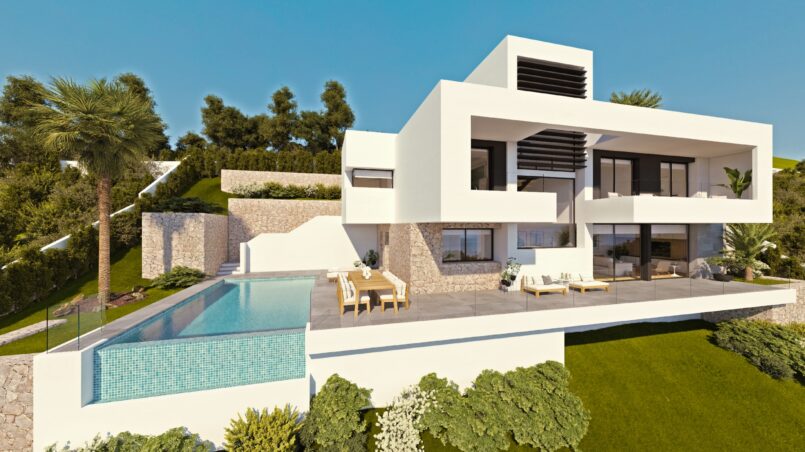In the heart of the Mediterranean, where the sun blesses the coast with its golden rays, the Spanish property market beckons with open arms, offering a myriad of opportunities for those seeking a place to call home. At the forefront of this promise are the enchanting towns of Altea, Finestrat, and Torrevieja. House for sale Altea, Finestrat, Torrevieja are not just listings; they are gateways to a lifestyle that combines the tranquility of the sea, the charm of Spanish architecture, and the warmth of local culture.
The Allure of Altea
Why Altea is a prime location
Nestled between the sea and the mountains, Altea offers a scenic escape with its cobblestone streets and whitewashed houses. This picturesque town is more than just a postcard scene; it is a place where community and culture thrive alongside the gentle waves of the Mediterranean.
Types of houses available in Altea
From quaint beachfront villas to luxurious hillside estates, Altea boasts a diverse range of properties that cater to every taste and need, offering breathtaking views and an unparalleled quality of life.
Finestrat – A Hidden Gem
Living in Finestrat
This charming village, set against the stunning backdrop of the Puig Campana mountain, is a treasure waiting to be discovered. Its proximity to Benidorm provides the perfect balance between tranquility and entertainment.
Benefits of buying in Finestrat
Investing in Finestrat is not just about acquiring real estate; it’s about embracing a lifestyle that is enriched by nature, history, and modern amenities, making it an ideal locale for families and retirees alike.
Torrevieja – Coastal Living
The lifestyle in Torrevieja
Torrevieja is a hub of activity with its vibrant promenades, marinas, and markets. It’s a city that combines the ease of coastal living with the vitality of urban amenities.
Investment potential in Torrevieja
The city’s developing infrastructure and the influx of tourism make it a promising area for investment, with properties continuing to appreciate as the region develops.
The Buying Process
Steps to owning a property
Purchasing a property in Spain is a straightforward process, punctuated by clear steps from initial viewing to final transaction, ensuring buyers can proceed with confidence.
Legal considerations
Understanding the legalities, including taxes, registration, and ownership laws, is crucial. It is highly recommended to engage with legal experts to navigate the complexities of the Spanish property market.
Market Trends
Current market analysis
Despite global economic fluctuations, the Spanish property market remains resilient, with areas like Altea, Finestrat, and Torrevieja showing sustained demand and steady growth.
Future prospects
The forecast for the property market in these areas is optimistic, with predictions of continued interest from international buyers and a flourishing local economy.
Financing Your Purchase
Mortgage options in Spain
Exploring the financing options available in Spain is essential. Buyers can find competitive mortgage rates, with banks and financial institutions offering various products tailored to non-residents.
Costs involved in purchasing
Apart from the purchase price, buyers should account for additional costs such as taxes, notary fees, and legal expenses, which are integral parts of the overall budget.
Property Viewing Tips
What to look for
When viewing properties, it’s important to consider location, condition, and potential for appreciation. Attention to detail can make all the difference in finding the perfect home.
Making the most of viewings
Maximize property viewings by preparing a checklist of preferences and concerns, allowing for an efficient and effective selection process.
The Role of Real Estate Agents
Choosing the right agent
Selecting a knowledgeable and experienced real estate agent is crucial in navigating the market and finding the best property that fits your criteria.
How agents can help
A good agent provides invaluable support, from identifying properties to negotiating prices and handling paperwork, making the buying process smoother and less daunting.
Renovation and Decoration
Renovating your Spanish home
For those looking to add a personal touch to their new home, the Spanish market offers abundant opportunities for renovation, with a wealth of local artisans and craftsmen.
Interior design tips
Incorporating Spanish design elements can give your home an authentic feel while allowing for modern amenities and personal expression.
The Community
Embracing the local culture
Integration into the community is a rewarding aspect of buying a home in Spain. Engaging with locals and participating in traditions can enrich the living experience.
Community involvement
Getting involved in local events and activities fosters a sense of belonging and helps build lasting relationships within the community.
Residency and Legalities
Residency requirements
For those looking to settle, understanding the residency requirements is key. Spain offers various residency options for property owners, including the Golden Visa for non-EU investors.
Navigating Spanish bureaucracy
Dealing with Spanish bureaucracy can be challenging, but with the right guidance and preparation, the process can be managed effectively.
Life After the Purchase
Settling in your new home
Transitioning into your new property involves more than just moving in. It’s about creating a home and embracing a new lifestyle in a vibrant community.
Maintaining your property
Owning a property in Spain comes with responsibilities. Regular maintenance ensures the longevity and value of your investment.
Selling Your Property
When it’s time to move on
If circumstances change, knowing how to navigate the resale market can help ensure a profitable and timely sale.
Maximizing resale value
Understanding the factors that affect resale value, from market trends to property condition, is essential for sellers looking to capitalize on their investment.
Conclusion Recapping the key points, it’s clear that the towns of Altea, Finestrat, and Torrevieja offer more than just property; they offer a chance to invest in a lifestyle that is as rewarding as it is beautiful. The Spanish property market, with its robust infrastructure and rich cultural tapestry, presents a compelling case for buyers and investors alike.
Key Takeaways
- Altea, Finestrat, and Torrevieja are not only beautiful destinations but also wise investments with a stable property market.
- The diversity of properties in these towns caters to a broad range of preferences and budgets.
- The Spanish property buying process is structured and secure, with an emphasis on transparency and legal compliance.
- The potential for property value appreciation in these regions is bolstered by ongoing development and tourism.
- Engaging with reputable real estate agents and legal professionals is crucial in facilitating a smooth purchase.
- Embracing the local community and culture enhances the experience of property ownership in Spain.
- Understanding the long-term aspects of property maintenance and potential resale is important for sustained investment success.
What makes Altea, Finestrat, and Torrevieja unique in the Spanish property market?
Altea, Finestrat, and Torrevieja each offer a unique slice of Spanish life, setting them apart in the property market. Altea is renowned for its historical beauty, traditional Spanish whitewashed houses, and artistic vibe. Finestrat combines the serenity of a traditional Spanish village with the dramatic landscape of the Puig Campana mountain as a backdrop. Meanwhile, Torrevieja is a lively coastal city known for its salt lakes, bustling promenades, and dynamic expat communities. Each location offers a distinct lifestyle: from tranquil, scenic living to vibrant urban energy. This variety means that property seekers can find a locale that matches their desired pace and style of living, whether they’re looking for cultural immersion, leisure, or investment opportunities.
Are there any specific legalities that non-residents should be aware of when buying property in Spain?
Non-residents buying property in Spain should be acutely aware of several legalities specific to their status. Firstly, they must obtain a Foreigner Identification Number (NIE), which is essential for any financial transaction in Spain. Non-residents are also subject to non-resident income tax, even if they do not earn income in Spain. Additionally, inheritance laws in Spain can differ significantly from other countries, potentially affecting future generations. It’s imperative for non-residents to understand the implications of these laws and plan accordingly. Engaging with a local legal expert is crucial, as they can provide guidance on these matters and any updates on Spanish property law that may impact the purchase or ownership of real estate.
How can buyers finance their property purchases in Spain?
Buyers can finance their property purchases in Spain through various means. Most commonly, mortgages can be obtained from Spanish banks, which offer products specifically designed for non-residents, albeit typically requiring a higher down payment. Interest rates in Spain are relatively competitive, and shopping around for the best rate is advisable. Other options include international lenders or private financing, which can sometimes offer more flexibility with repayment terms. Buyers must be prepared for additional costs such as appraisal fees, opening commissions, and currency exchange implications if they are bringing funds from abroad. It is important to have a clear financial plan in place and consider all associated costs beyond the purchase price when financing a property in Spain.
What should potential buyers look for during property viewings?
During property viewings, potential buyers should look beyond the aesthetics of a property and assess its structural integrity, including signs of dampness, the condition of the roof, plumbing, and electrical systems. It’s also important to consider the property’s orientation—how it captures light and whether it offers energy efficiency benefits. The location’s connectivity, amenities, and potential noise levels are crucial for lifestyle compatibility. For investment properties, consider the local rental market, seasonal demand, and long-term development plans that could affect value. Buyers should envision not only the property’s current state but also its potential, including renovation scope and regulatory permissions. A thorough viewing checklist can help ensure that critical factors aren’t overlooked in the decision-making process.
What are some tips for integrating into the local Spanish community?
Integrating into the local Spanish community can be a fulfilling experience. It begins with learning the language; even basic Spanish can go a long way in showing respect and willingness to engage with locals. Participation in community events, festivals, and markets is essential—it’s an opportunity to understand the culture and make connections. Patronizing local businesses and eateries also helps in building relationships. Moreover, being open to new customs and traditions, and showing curiosity about the local history and way of life will endear you to the residents. Volunteering or joining local clubs and organizations can provide deeper engagement with the community. Remember, integration is a gradual process that requires patience, openness, and a positive attitude.







